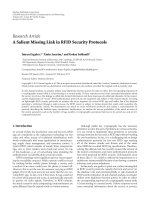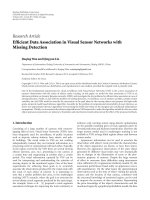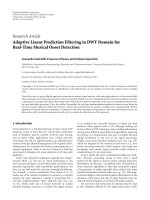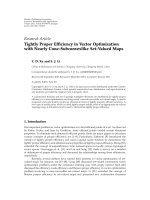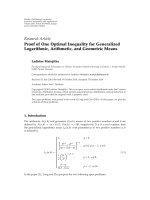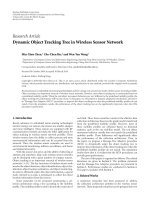Báo cáo hóa học: " Research Article Priority-Based Heading One Detector in H.264/AVC Decoding" pdf
Bạn đang xem bản rút gọn của tài liệu. Xem và tải ngay bản đầy đủ của tài liệu tại đây (586.54 KB, 7 trang )
Hindawi Publishing Corporation
EURASIP Journal on Embedded Systems
Volume 2007, Article ID 60834, 7 pages
doi:10.1155/2007/60834
Research Article
Priority-Based Heading One Detector in H.264/AVC Decoding
Ke Xu, Chiu-Sing Choy, Cheong-Fat Chan, and Kong-Pang Pun
Department of Electronic Engineering, The Chinese University of Hong Kong, Shatin, Hong Kong
Received 11 July 2006; Accepted 31 January 2007
Recommended by Jarmo Henrik Takala
A novel priority-based heading one detector for Exp-Golomb/CAVLC decoding of H.264/AVC is presented. It exploits the statis-
tical distribution of input encoded codewords and adopts a nonuniform partition decoding scheme for the detector. Compared
with a conventional design without power optimization, the power consumption can be reduced by more than 3 times while the
performance is maintained and the design hardware cost does not increase. The proposed detector has successfully been verified
and implemented in a complete H.264/AVC decoding system.
Copyright © 2007 Ke Xu et al. This is an open access article distributed under the Creative Commons Attribution License, w hich
permits unrestricted use, distribution, and reproduction in any medium, provided the original work is properly cited.
1. INTRODUCTION
The Moving Picture Experts Group and the Video Cod-
ing Experts Group (MPEG and VCEG) have jointly devel-
oped a new video coding standard named as H.264/AVC [1].
Compared with previous coding standards like MPEG-2 or
H.263, it achieves nearly the same video quality (by means
of PSNR and subjective testing) while requiring 60% or less
of the bit rate [2]. This substantial improvement comes at
a price of extraordinarily huge computational complexity
and formidable memory access, which in turn incur g reater
power consumption.
On the other hand, CMOS technology has now entered
the “power-limited scaling regime,” where power consump-
tion moves from being one of many design metrics to be
number one design metric. The H.264/AVC processing de-
mands much greater power than MPEG-2 or H.263 due
to increased complexity. Therefore, its power consumption
should be carefully managed to meet power budget, espe-
cially for applications on portable devices. Although power
dissipation can be substantially reduced through technology
scaling, where designers switch to a smaller geometry to im-
plement the same circuit, power reduction through proper
design techniques is more flexible and extensive, especially
where geometry scaling is not applicable.
H.264/AVC standard defines a hybrid block-based video
codec, which is in general similar to early coding stan-
dards, but the impor tant changes occur in the details of
each functional block with many new coding techniques.
One of these techniques occurs in entropy coding, where
two methods, Exp-Golomb for syntax elements above the
slice layer and CAVLC (context-adaptive variable-length cod-
ing) for quantized transform coefficients, are supported in
the baseline profile [3]. During the decoding process, all the
Exp-Golomb coded syntax elements require the identifica-
tion of the position of the first appeared “1” inside each code-
word. For CAVLC decoding, some parameters like TotalCo-
eff,level
prefix, and total zeros t ables [1] also need to iden-
tify this first “1” before lookup table operation happens.
Conventional detectors usually are not aware of power
consumption. One such example is descr ibed in [4]which
splits the 16-bit input into 4 parts (4-bit vectors), each of
which detects whether there is a “1” among the four input
bits. Then these results will determine which part should be
further tested. Although the method works well, it is not a
power-efficient technique since it treats all the 16 input bits
with equal importance. The power consumption bears no re-
lationship with the occurrence of any codewords; no matter
how likely they will occur.
General low-power design techniques have been devel-
oped for many years. Besides these general methods, video
decoding presents a unique power optimization opportu-
nity due to temporal, spatial, and statistical redundancies
in digital video data. In this paper, we mainly utilize sta-
tistical redundancy during video decoding. A data-driven
priority-based heading one detector is proposed, which de-
tects the heading “1” in a bitstream that is organized in 16-bit
units. The key idea of our proposal is to exploit the statistical
characteristics of the heading one position among the vari-
ous codewords. A nonuniform decoding scheme is designed
2 EURASIP Journal on Embedded Systems
Input bitstream buffer
Variable length Fixed length
Heading one
detector
Length
feedback
Exp-Golomb
decoder
CAVLC
decoder
Fixed-length
decoder
Parameter
generation
Control signal
generation
Reconstruction data path
Figure 1: Decoder system architecture.
accordingly. By selectively disabling some subblocks, the de-
tector consumes much less power without noticeable perfor-
mance degradation and even smaller design area.
2. BACKGROUND
In this section, we firstly give a brief introduction of the
whole decoder architecture. Then we discuss the structure of
Exp-Golomb code and CAVLC code which requires heading
one detection. At last, we evaluate the related research works
in literature.
2.1. H.264/AVC decoding
A simplified system architecture of the whole decoder is il-
lustrated in Figure 1. According to input codeword type,
the heading one detector is invoked when current codeword
is Exp-Golomb coded or a certain part of CAVLC code-
words. Based on the output of the heading one detector, Exp-
Golomb codes are mapped from bitstream form to signed,
unsigned, or truncated syntax element values, while CAVLC
codes are indexed for several lookup Tables (LUT). There
is a length feedback signal from the heading one detector,
CAVLC decoder, and fixed-length decoder to the input bit-
stream buffer. The signal indicates how many bits are con-
sumed for decoding current codeword. According to de-
coded codewords, related parameters and control signals are
generated to orchestrate the following reconstruction data
path.
2.2. Heading one detection
Figure 2 depicts a normal input to the heading one detector,
where the detector needs to search among the 16 bits to find
Heading one position = 3rd, bit2
001011010 1111101
Bit0 Bit15
Figure 2: Heading one position.
Table 1: Exp-Golomb codewords.
Code num Codeword
01
1 010
2 011
3 00100
4 00101
5 00110
6 00111
7 0001000
8 0001001
···
[M zeros][
1][INFO]
the first appeared “1.” Here we assume the input bitstream
is encoded from left to right. This example indicates that the
heading one position lies at third place (bit2). Although there
are several “1’s” at some other positions like bit4, bit5, and so
forth, they are not heading ones.
Exp-Golomb codes
Exponential Golomb codes (see [5]) are variable-length
codes with simple and regular structure as depicted in
Tabl e 1. One does not need to store the conversion table for
the purpose of decoding, since the correspondence between
symbols and codes is mathematically defined. The leading M
zeros, as well as the middle “1,” are treated as “prefix” of the
codeword, while INFO, which is equal in length to the M
zeros, is called “suffix” [6]. In Table 1, the first code
num
“0” does not contain any leading zero or trailing INFO.
Code
nums “1” and “2” have a single-bit leading zero and
corresponding single-bit INFO field, code
nums 3 ∼6havea
two-bit leading zeros and INFO field, and so on. Theoreti-
cally the codeword table can be infinitely extended a ccording
to the coding rule described. The length of each Exp-Golomb
codeword is (2M + 1) bits long and each codeword can be in-
ferred by the following equation [6]:
M
= floor
log
2
code num + 1
,
INFO
= code num + 1 − 2
M
,
(1)
where floor (x) is a func tion finding the largest integer which
is less than or equal to x.
In H.264/AVC standard, there are three types of Exp-
Golomb coding: unsigned, signed, and truncated. They
all follow the same coding rule and are only different in
whether an additional “code
num to syntax value” mapping
is needed.
Ke Xu et al. 3
Coeff token
LUT
270 entries
Heading one
detector
Coeff
token
decoding
Tot al Co eff
and
trailingOnes
16
Run
before
decoding
Tot al
zeros
decoding
16 16
Tot al zeros
Level
prefix
Level
decoding
CAVLC
decoding
T1
decoding
Heading
one detector
Heading
one detector
Tot al
zeros
LUT
135 entries
Level
prefix
LUT
16 entries
Figure 3: CAVLC decoding flow.
Table 2: Codeword table for level
prefix.
level prefix Bit string
0 1
1 01
2 001
3 0001
4 0000 1
5 0000 01
6 0000 001
7 0000 0001
··· ···
CAVLC
Amoreefficient algorithm for transmitting the quantized
transform coefficients is proposed in [3]. In this method,
VLC tables for various syntax elements are selected depend-
ing on already transmitted syntax elements. To decode the in-
dexes for some of these VLC tables, a heading one detector is
indispensable. The CAVLC decoding step is briefly described
in Figure 3.
The CAVLC decoding can be partitioned into five steps
and three of them require heading one detection.
Table 3: Total zeros table for 4×4 blocks with TotalCoeff (co-
eff
token) 1 to 3.
Total zeros TotalCo eff (coeff token)
123
0 1111 0101
1 011 110 111
2 010 101 110
3 0011 100 101
4 00100110100
5 0001 10101 0011
6 0001 00100 100
7 0000 110011011
Tabl e 2 shows one VLC table [1]inCAVLCcodes
which maps input bit stream to “level
prefix.” T he value of
level
prefix is directly determined by the position of the first
appeared “1.” Table 3 shows another VLC example where
finding the heading one position is sufficient for the whole
syntax element to be extracted.
Since most of the syntax elements are coded either as
Exp-Golomb codes or CAVLC codes, heading one detector
is used extensively in H.264/AVC decoding.
2.3. Related works
Although there are some designs in literature dealing with
Exp-Golomb or CAVLC decoding [4, 7–9], few of them men-
tioned how heading one detection was realized. The only ref-
erence design is found in [4]. It proposed a detector that
evenly splits the input into four subwords. From each sub-
word, the presence of “1” is detected. Then these results will
determine which subword should be further tested, as shown
in Figure 4. Priority encoder0’s output indicates the position
of “1” in the subword, while priority encoder1’s output in-
dicates which subword has the heading one. In fact, this is a
two-level encoder and cannot run in parallel. Encoder1 se-
lects a subword based on priority where part [3 : 0] has the
highest priority and part [15 : 12] has the lowest priority. Ac-
cording to encoder1’s indication, encoder0 chooses one cor-
rect subword among the four and encodes the heading “1”
in the chosen subword as the final heading one position. No
matter where the heading one is, four subword decoders and
two priority encoders are ac tive all the time.
3. PROPOSED ARCHITECTURE
In this section, we firstly explore the heading one statistics in
entropy coding. Based on the observation, a priority-based
heading one detector is then proposed.
3.1. Characteristic of entropy coding
As aforementioned, design in [4]proposeda“first1detec-
tor” based on a uniform input bit-vector partition. T hat is an
effective scheme but no power optimization was considered.
4 EURASIP Journal on Embedded Systems
[15 : 12] [11 : 8] [7 : 4] [3 : 0]
Mux
4
Priority
encoder0
Priority
encoder1
24
4
Figure 4: Evenly partitioned detector in [4].
Since both Exp-Golomb and CAVLC codings are entropy
coding methods, they have the same important characteris-
tic like all other entropy coding schemes: shorter codewords
are assigned to symbols that occur with higher probabil-
ity, whereas longer codewords are assigned to symbols with
less frequent occurrences. In an H.264/AVC bitstream, the
longest code is 16 bits including the heading “1.” However,
the average length of such kind of codes is not (16 + 1)/2
=
8.5, but much smaller.
3.2. SystemC modeling
In order to study the entire bitstream parsing process where
entropy decoding is included, we developed a high-level s ys-
temC model, emulating the control and communication of
real video decoding. Its output is compared with JM9.4 soft-
ware [10] to verify correct function. The systemC model has
internal counters to count the total number of Exp-Golomb
codes and CAVLC codes which require heading one detec-
tion. It also has individual counters for the number of these
codes under different heading one positions. Five popular
test videos, named as container, foreman, akiyo, news and
carphone, with QCIF 300 frame sequences at 30 fps are used.
They are encoded by JM software with quantization param-
eters set to 22, 25, 28, 32, and 36, respectively. The statistical
profile of heading one’s positions was hence obtained from
simulation with these input bitstreams.
The average codeword lengths are found as in Table 4
(note that if a “1” is in the first bit, this corresponds to po-
sition
= 0 and so on). The intraframe and interframe have
slightly different heading one statistical position percentage
since usually the intraframe has more residual information
Table 4: Statistic result of heading one position (nearly 0 means
that percentage is less than 0.01%).
Position
Whole input
bitstream
Intracoded
frame
Intercoded
frame
0 55.36% 51.37% 56.61%
1 24.15% 24.36% 24.08%
2 11.16% 10.70% 11.31%
3 5.49% 6.21% 5.26%
4 2.17% 3.69% 1.72%
5 0.88% 1.6% 0.65%
6 0.41% 0.91% 0.25%
7 0.16% 0.4% 0.08%
8 0.08% 0.25% 0.03%
9 0.06% 0.24% 0.01%
10 0.04% 0.15% Nearly 0
11 0.01% 0.06% Nearly 0
12 Nearly 0 0.04% Nearly 0
13 Nearly 0 0.03% Nearly 0
14 Nearly 0 Nearly 0 Nearly 0
15 Nearly 0 Nearly 0 Nearly 0
Average 0.81 1.12 0.74
and needs more CAVLC decoding effort. For example, in-
side interframe, positions equal to or above 10 begin to have
nearly zero (less than 0.01%) codes distribution, whereas for
intra frame, this boundary is pushed to a high position which
indicates that only positions 14 and 15 have nearly zero codes
distribution. However, both intra- and interframes-share the
same tendency that the higher the position is, the less oppor-
tunity that a heading one is found.
Be aware that the statistical positions stated in Ta bl e 2 are
not a simple average of the values in the intra- and the inter-
frame columns. This is because intra- and interframes have
different total numbers of Exp-Golomb/CAVLC codes in dif-
ferent test video sequences. For example, in akiyo video se-
quence of 300 frames, 24% of codes need heading one detec-
tion are extracted from intraframes and 76% are extracted
from interframes, while in foreman video sequence, 30% of
these codes are extracted from intraframes and 70% are from
inter frames. In addition, distributions of heading one po-
sitions (position
= 0, 1, 2, ) in a single video sequence
vary from one bitstream to another. These nonuniform code-
words distributions lead to the nonlinear relationship of total
average positions for intra- and interframes. In addition, po-
sitions of interframes tend to have a larger weight than those
of intraframes in all the video sequences tested, for there are
more intercoded frames than intra-coded ones.
According to Tab le 4, the heading one in a codeword is lo-
cated on average in a position indicated in Figure 5.Wecon-
clude that the average heading one position for the whole se-
quence/intraframe/interframe is 0.81/1.12/0.74, respectively,
which are much smaller than the simple average of 8.5. Of
course, positions naturally are whole numbers, fractional
values are the artifacts of averaging.
Ke Xu et al. 5
0.74: average position of interframe
0.81: average position of whole sequence
1.12: average position of intraframe
Bit0 Bit1 Bit2 Bit3
··· Bit15
Figure 5: Average heading one position.
Input bitstream [0 : 15]
Heading one
detector enable
100%
active
01
Dec2 Enable
En.
20%
active
2345
Dec4
Enable
1%
active
6 7 8 9 10 1112 13 14 15
Dec10
4
2
1
Priority encoder
4
Data signals
Control signals
Figure 6: Proposed heading one detector.
3.3. Proposed architecture
From the above analysis, we conclude that the position of
heading one most likely lies around the second input bit
(position
= 1). The first two positions (position0 + posi-
tion1) account for almost 80% of all cases and the first six
positions (position0 +
··· + position5) account for nearly
99%. Thus we propose a priority-based nonuniform parti-
tion heading one detector where the input 16 bits are divided
into 3 unequal subdetectors and each subdetector can be se-
lectively enabled and disabled. Figure 6 shows the proposed
scheme.
In our design, input bitstream from bitstream buffer is
controlled by an “enable” signal. If current codeword needs
heading one detection, the whole 16 bits are enabled and
passed to the heading one detector, else the detector is dis-
abled to reduce unnecessary switching. The entire detector
is partitioned into three parts, each of which handles a dif-
ferent chunk of input bits with varying priority. Dec2, which
has the hig h est priority, processes the first two input bits and
is active al l the time to detect whether there is a “1” and its
corresponding likely position (only first bit position or sec-
ond bit position here). If a “1” is found in dec2, which signals
a successful identification of the heading “1” in a codeword,
the position information is passed to the final priority en-
coder to generate a heading one position. At the same time,
the lower-priority dec4 and the lowest-priority dec10 are dis-
abled to save power. Conversely, there is a 20% possibility
that dec2 will fail to find a “1” and dec4 will be enabled there-
after. More rarely, both dec2 and dec4 cannot find a heading
one and dec10 will then be active but having only 1% pos-
sibility. The outputs of dec2, dec4, and dec10 are selectively
encoded as heading one position of whole 16-bit input by a
priority encoder.
Design in [4] divides 16-bits input evenly into 4 identi-
cal subwords. Each subword decoder detects whether there
is a “1” inside and their outputs are then sent to two prior-
ity encoders. No matter whether the “1” found in each sub-
word is a heading “1,” all four subword decoders, as well as
the priority encoders, are active all the time. However, if the
first decoder which looks at bits [3 : 0] finds a “1,” no mat-
ter what the outcome of the other three decoders is, one can
conclude that the first “1” is in bits [3 : 0]. The work done
by the other three decoders is of no consequence and only a
waste of power.
4. DESIGN ANALYSIS
In this section, we mainly discuss and compare the power
consumption of [4] and the proposed design. We also discuss
the speed and area overheads.
4.1. Theoretical analysis
Stric tly speaking, power consumption constitutes of dynamic
power and static power. Since the target process is a relatively
standard CMOS 130 nm technology and the circuit is small
enough, the static power only contributes a very small por-
tion of the whole power consumption. Therefore, we can as-
sume that the detector’s entire power is proportional to dy-
namic power to facilitate our calculation. Average power dis-
sipation for decoding each heading one position can be mod-
eled as suggested in [11]
E
avg
=
N
i=1
P
i
E
i
,(2)
where P
i
is the probability that heading position = i will oc-
cur, E
i
is the energy required to detect such a position, and
N is the total number of possible positions where N
= 16 for
H.264/AVC codes.
Since dynamic power consumption is almost linear to the
complexity of these decoding units, without loss of general-
ity, one can assume the power consumed by dec2 is 2 units,
dec4 is 4 units, and dec10 is 10 units. In [4], all the four de-
coders are identical and consume 4 units of power all the
time.
Estimated power consumption for the detector in [4]is:
E
avg
=
4
i=1
P
i
E
i
= 4 × 100% × 4 units = 16 units. (3)
In our scheme, three decoders are active sequentially and
their activation rate is proportional to the heading one dis-
tribution shown in Table 4.
6 EURASIP Journal on Embedded Systems
Table 5: Layout power analysis.
Power consumption at 20 MHz
real-time QCIF/30 fps
Frame type
Implementation
of [3]
Our
proposal
Power
reduction
Intra frame 13.45 µW3.99µW3.38times
Inter frame 2.35 µW 0.733 µW3.21times
Table 6: Physical implementation.
Technology UMC 130 nm
Metal layer 6 metals, 2 thick
Supply voltage 1.08 v
Max. frequency 200 MHz
Estimated power consumption for our schemeis
E
avg
=
3
i=1
P
i
E
i
= 100% × 2 units + 20% × 4 units + 1% × 10 units
= 2.9 units.
(4)
The percentages in the above equation reflect the activity rate
of each submodule dec2 (for position 0
∼1), dec4 (for posi-
tion 2
∼5), and dec10 (for other positions), respectively. The
overhead-like power consumed by muxes is negligible. T he
relative power saving for our scheme is about 5.5 times while
the throughput is nearly the same.
4.2. Implementation analysis
Since there is no power consumption figures reported in [4],
to have a fair comparison, we built a “heading 1 detector” ac-
cording to [4] with the same process technology used for our
scheme. Both of the detectors are integrated into H.264/AVC
decoding system, where there is a switch to control which one
is currently active. The decoding system is simulated by Mod-
elSim. The Verilog RTL codes are then synthesized by design
compiler and are placed and routed by Astro. Parasitic in-
formation is extracted by Star-RCXT and postsimulation is
processed in VCS. Based on the layout database and individ-
ual activity rate obtained from post-sim, postlayout power
analysis results can be obtained from PrimePower, shown in
Tabl e 5. The key implementation parameters of our scheme
are listed in Table 6. Considering that the heading one de-
tector has the highest switching ac tivity in entropy decoding,
the power reduction contributable by such a detector is sub-
stantial.
According to Tables 5 and 6, one can conclude that our
design not only consumes less power, but is capable of per-
forming real-time decoding. The circuit size is even a little bit
smaller than the design in [4]. Although a larger dec10 is in-
troduced, two priority encoders found in [4] are reduced to
one which leads to slight area reduction. The only penalty is
a small throughput degradation if the heading one happened
to be at a higher position like 6, 7, and so forth, because dec2,
dec4, and dec10 w ill need to be triggered in sequence to ob-
tain the final result. Even at this extreme case, the proposed
design can achieve a maximum frequency of 200 MHz, which
is substantially faster than other building blocks in the whole
H.264/AVC decoding system.
The advantage of our design is drawn from exploiting the
high probability of “heading one” lying in the first few bits
of a codeword. By using a nonuniform decoding structure, a
lot of power is saved because one does not need to search all
bits. The same technique can also be applied to other entropy
decodings such as that in MPEG-2. Although the codeword
structure is not identical as in H.264/AVC, short codewords
inherently occur more frequently. Proposed technique can
then be employed according to the specific statistical profile
found from high-level modeling.
5. CONCLUSION
A priority-based, data-driven power-efficient heading one
detector has been proposed. The opportunity to reduce
power is identified at architectural level through systemC
modeling. Appropriate circuit implementation is then cho-
sen. It exploits the statistical codeword distribution of an
entropy-coded bitstream, and a novel power-saving decod-
ing scheme is subsequently devised. Compared w ith conven-
tional detectors, the proposed design achieves more than 3
times power reduction while maintaining area and speed per-
formance. It does not utilize any special techniques such as
clock gating or voltage scaling, and thus makes it readily em-
ployable in other circumstances when different technologies
may be used. Since power consumption in ICs is a critical is-
sue in recent years, this paper suggests an effective method to
reduce power by exploiting statistical characteristics.
ACKNOWLEDGMENT
The work reported is supported by a Hong Kong SAR Gov-
ernment Research Direct Grant no. 2050322.
REFERENCES
[1] J. V. Team, “Advanced video coding for generic audiovisual
services,” ITU-T Recommendation H.264 and ISO/IEC 14496-
10 AVC, May 2003.
[2] T. Wiegand, H. Schwarz, A. Joch, F. Kossentini, and G. J. Sulli-
van, “Rate-constrained coder control and comparison of video
coding standards,” IEEE Transactions on Circuits and Systems
for Video Technology, vol. 13, no. 7, pp. 688–703, 2003.
[3] T. Wiegand, G. J. Sullivan, G. Bjntegaard, and A. Luthra,
“Overv iew of the H.264/AVC video coding standard,” IEEE
Transactions on Circuits and Systems for Video Technology,
vol. 13, no. 7, pp. 560–576, 2003.
[4] W. Di, G. Wen, H. Mingzeng, and J. Zhenzhou, “An Exp-
Golomb encoder and decoder architecture for JVT/AVS,” in
Proceedings of the 5th International Conference on ASIC, vol. 2,
pp. 910–913, Beijing, China, October 2003.
Ke Xu et al. 7
[5] S. W. Golomb, “Run-length encoding,” IEEE Transactions on
Information Theory, vol. 12, no. 3, pp. 399–401, 1966.
[6] I. E. G. Richardson, H.264 and MPEG-4 Video Compression,
John Willey & Sons, New York, NY, USA, 2003.
[7] Joint Video Team (JVT) reference software JM9.4, http://
iphome.hhi.de/suehring/tml/download/.
[8] T C. Wang, H C. Fang, W M. Chao, H H. Chen, and L G.
Chen, “An UVLC encoder architecture for H.26L,” in Proceed-
ings of IEEE International Sy mposium on Circuits and Systems
(ISCAS ’02), vol. 2, pp. 308–311, Phoenix, Ar i z, USA, May
2002.
[9] S. H. Cho, T. Xanthopoulos, and A. P. Chandrakasan, “A low
power variable length decoder for MPEG-2 based on nonuni-
form fine-grain table partitioning,” IEEE Transactions on VLSI
Systems, vol. 7, no. 2, pp. 249–257, 1999.
[10] I. Amer, W. Badawy, and G. Jullien, “Towards M PEG-4 part
10 system on chip: a V LSI prototype for context-based adap-
tive variable length coding (CAVLC),” in Proceedings of IEEE
Workshop on Signal Processing Systems (SIPS ’04), pp. 275–279,
Austin, Tex, USA, October 2004.
[11] H Y. Lin, Y H. Lu, B D. Liu, and J F. Yang, “Low power de-
sign of H.264 CAVLC decoder,” in Proceedings of IEEE Inter-
national Symposium on Circuits and Systems (ISCAS ’06),pp.
2689–2692, Island of Kos, Greece, May 2006.
